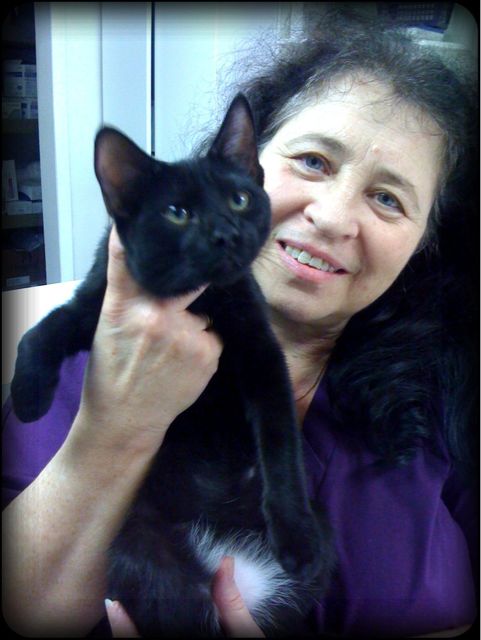Rescued "3-Legged" Kitten Healed by Kindness and Time
Without kind rescuers, even if they cannot keep a kitten in their home for a variety of reasons, and benefactors to provide supplies and healthcare, and a generous nurse who fosters the kitten as her own, a street kitten has a very short expected lifespan. Especially if the kitten has a paralyzed leg.
A sorry sight, the eight week old kitten was dehydrated, starving, and his right arm flipped around uselessly. He couldn’t feel his leg and it flopped out from his ribs like it was barely attached. His elbow was swollen and fixed in a bent position, with a two inch round open sore on the inside of his elbow area.
X-rays showed an old break, poorly healed, right at the growth plate where the humerus meets the elbow. His rescuers wanted to know what needed to be done to ensure a normal leg and a normal life.
While they couldn’t keep a cat in their condominium, they committed to providing the best healthcare. The real trick was figuring put what really was the right medical course of action.
After consulting several kind, respected Specialists, we decided to wait and see how the kitten would grow. We used the following criteria to be sure we were being fair to him:
1. Be certain he had no pain
2. Be certain he had no lingering nidus (focal point) of infection that would reactivate and make him feel sick
3. Be certain he could move and play without hurting himself, causing the leg to become raw or sore
4. Be certain no early surgery or medical intervention could prevent further damage in the future.
We could figure out the first three on our own. He grew, ate, had no fever, and could not feel the leg- so no pain! We worried he might feel frustration or discomfort about his abnormal leg. After watching him play, we realized that hecthought the leg was normal; it was just a part of him.
The Specialist confirmed my assessment:
“You don’t have an elbow joint left to save; he probably had a brachial plexus avulsion (armpit stretches so much nerves and sometimes blood vessels and muscle attachments rip), and the growth plate is probably damaged so it won’t grow any more. It’s best, in this case, to wait and see how he grows.”
His rescuers were very disappointed. Honestly, usually when people fond a cat or kitten, they do the best they can afford to help the cat, often not affording specialists or surgery. In this case, his people would do anything. They asked about elbow replacement surgery, rebreaking and setting the leg, how to stimulate the growth plate. Not options ethically, practically, or medically in 2009!
They wanted me to answer, “How will his life be? Will he be normal?” These answers are beyond medicine and into the realm of time and destiny.
One afternoon, I passed his cage in our treatment area and he was playing in the kitty faut sheepskin bed and stalking anything that appeared just over the horizon of the rounded edge of the bed. His little head jiggled, his eyes fixed, ears perked forward, tail twitching back and forth and butt wiggling in the air. First my fingers, then my pen, the stethoscope dangling from my neck, and my long straight hair all fell prey to his stalking.
Then his crooked little foot dangled over the edge of the bed as he lay on his side. He stalked his paralyzed foot like it was the best toy ever. He gave it a few hind leg bunny kicks and a few bites until he bored of the game and fell asleep.
Uh oh! What if he continues to attack his own foot, as if it were not alive and attached to his body? Instead of outwardly panicking (which is how I felt), I stayed cool and mentioned to his nurse to keep an eye on the play style and intervene if he started hurting himself. He never did.
He spent the nights at my nurse’s home, riding up under her fluffy white dog’s tail like a swashbuckling adventurer, and the days partly in a cage at work, and mostly loose and playing in an extra examination room.
Each day he comes to work with his nurse foster mom, his rescuers came to visit and play with him for an hour.
“Doctor, come see what he can do!”
There he was, swatting at a string and feather toy with his bent, paralyzed right paw. He learned to throw his shoulder muscle and swat the dangling leg around like an uncoordinated kitty paw tennis raquet.
Now, five weeks after the little kitty was rescued off a street, he faces a bright future. He’s healthy and happy with his normal three legs and he a acts like the crooked right leg poses no issues for him.
His one remaining deficiency actually reflects his human’s shortcomings: we don’t really have a name for him. For now, we call him, “Puppy.”






